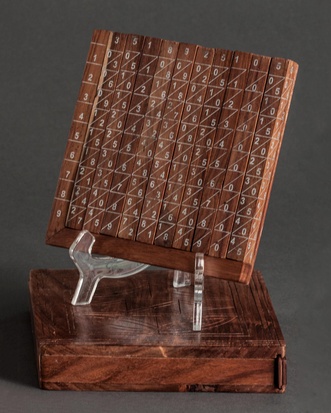Napiers' Bones
- Designer :
- John Napier
- Year :
- 1614
In the early 1600s, a Scottish mathematician named John Napier invented a tool called Napier's Bones, which are multiplication tables inscribed on strips of wood or bone. Napier, who was the Laird of Merchiston, also invented logarithms, which greatly assisted in arithmetic calculations.
In 2008, Bob Roswell traveled to New York to bid on an original copy of Napier's 1614 paper describing the bones. He thought he had lost his mind when he bid $5,000. It sold for $80,500!
The basic design included a base with nine rows labeled one to nine along the left hand side. The area to the right was recessed so ten “bones” could be inserted with each one having a series of progressive calculations for each digit creating, at first glance a multiplication table. The first row would simply include digits 1,2,3…..0 reflecting the multiplication result of each digit times one. The subsequent rows had a horizontal slash, the digit to the left of the slash represented values in the tens column; the values to the right represented single digit values. As such, the first bone’s second row would show 0/2, the multiplication of 1x2, zero value in the ten column, 2 in the single digit column. Likewise, tow six of the sixth bone showed “3/6” for 36, three ten’s, and six single digits. Setup this way, Napier’s Bones is simply a multiplication table showing the values for all operations multiplying a single digit times a single digit. By arranging the “bones” and following the matrix, complex multiplication problems could be calculated. Different arrangements were used for division and square roots.

